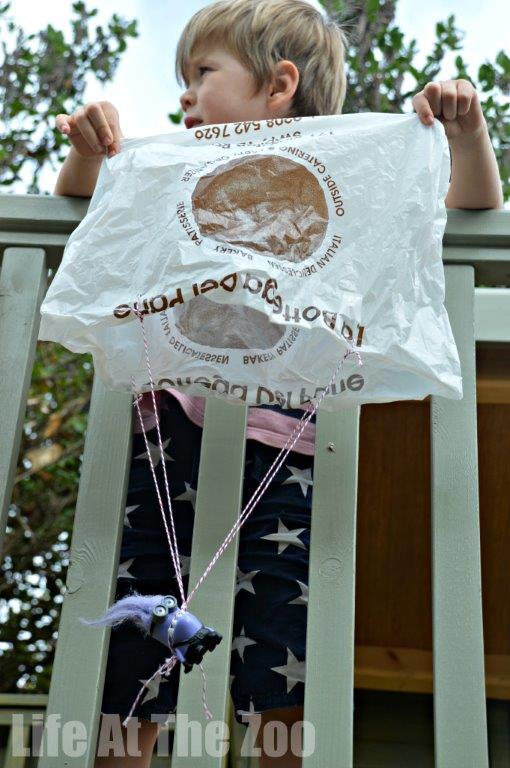Parachute Experiment – Science at Home
Our Science at Home series continues.. every couple of weeks, parent and science bloggers get together to share some Science activities under a certain theme. We now decided to explore the 4 elements – Earth, Water, Air and Fire – and see what science activities we could come up with to relate to those! We kicked the series off with “Air Experiments”. What experiments can we explore that relate to Air?
Ours is a simple one. First we discussed Pinwheels again – which we last looked at in our Weather Science Experiments video.
We also decided to look at the properties of air and how we can “Play” with them by making a simple plastic bag parachute. Yep, super duper easy to make and lots of fun.
 Keeping watch for a gust of wind.
Keeping watch for a gust of wind.
Materials: as big and thin as possible plastic bag, scissors, tape and lightweight strings, objects to hang from it.
1) I cut the sides of the bag to open it up as much as possible (basically taking the handles off).
2) Then taped 4 corners to reinforce where I was going to put the holes.
3) Cut some holes across the tape and tie you string.
The Experiment:
We tried out different toys to see which would “fly” best. We found that the heavy toys would come straight down and that small toys had a chance to “billow out” and float. We also tried out different heights. Our little “playhouse” was a great platform to launch from, but suspect a bedroom window would be even better. We also tried throwing it “up in the air” and that work pretty well too – as you are able to get the object higher up and there is more time for the parachute to open up and “catch the air”.
The Parachute Science:
So what is happening? Why did smaller/ lighter toys buy propecia price work better? What did the plastic bag do? And why was it more fun when there was a gust of wind?
All things on Earth “fall down” due to gravity. Gravity is the force between two objects – and as the earth is so big, it has a very strong force, pulling things towards it (Science detour: the moon is much much smaller, and the gravity is much less strong – this is why astronauts feel much lighter and can bounce around).
Now, air is made up of lots of tiny particles, which cause “resistance” – like a break stopping us from falling. When you use a parachute you are creating a big surface area that halps magnify the effect of this resistance, slowing down your fall.
The speed of your parachute is determined by the resistance that the air causes (you could calculate it based on the surface size) and the weight of your toy – which determines how strong the force is pulling it down (again, you can calculate this – in Physics terms, you would write F = m (mass) x g (gravity)). These two forces work against each other and determine your final speed.
What does the gust of wind have to do with it? The gust of wind, is air travelling at speed – which also means it has a “force”, this blows into the parachute and works against the force pulling it down.
Anyway.. just go out and play. Introduce words such as “gravity” and “forces” and explore what happens!!!
Watch our Air Experiment Video for more ideas:
In order of appearance:
1) We have the Parachute experiment described above
2) We have Blue Bear Wood exploring Lungs
3) We have Rainy Day Mum discussing “rising hot air” and how we can “see it”
4) Finally, our host Inspiration Laboratories watching “air move” through cloud spotting.



